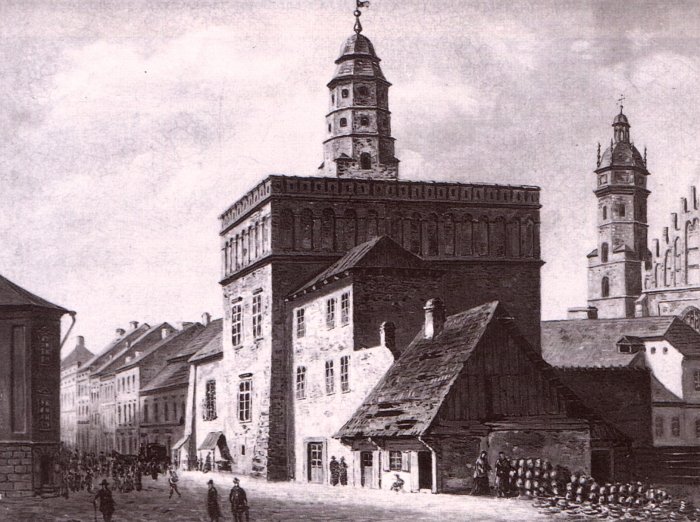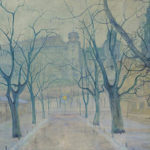 Żydowskie Miasto
Żydowskie Miasto
Żydowski Kazimierz każdy zwiedza według własnego klucza. Ktoś trzyma się przewodnika, ktoś inny daje się nieść plątaninie uliczek, często wracając pięć razy do tego samego miejsca. Jednym wystarczy 10 minut marszu i odchodzą zdegustowani w „ładniejsze i mniej nędzne” rejony, inni potrafią spędzać tu długie godziny, dlatego trudno narzucać kierunki czy kolejność zwiedzania tej dziwnej dzielnicy. Na wpół zrujnowana, zachowała niezwykłą atmosferę, która wzbudza tak odmienne emocje.
Z okresu autonomii Kazimierza pozostały dwa ważne atrybuty jego miejskości: dawny ratusz – dziś siedziba Muzeum Etnograficznego, i rynek – dziś plac Wolnica.
Jasny, graniasty budynek Muzeum Etnograficznego został wzniesiony w 1414 r. z przeznaczeniem na ratusz miasta Kazimierza. Po przebudowach i remontach udało mu się przetrwać w szacie renesansowej, której najozdobniejszym elementem jest krenelażowa attyka. Po przyłączeniu Kazimierza do Krakowa ratusz stracił jednak rację bytu i gmach wystawiono na licytację. Do 1947 r. mieściły się tu różne biura i szkoły – w tym żydowska, później oddano dawny ratusz Muzeum Etnograficznemu.
Zbiory Muzeum Etnograficznego im. Seweryna Udzieli na pewno nie znudzą. Co więcej – mogą natchnąć i zadziwić. Wśród ponad 60 tys. eksponatów najliczniej prezentowana jest sztuka ludowa Polski. Zgromadzono tu między innymi kolekcję polskich strojów ludowych, najpiękniejsze (wszystkie nagrodzone) szopki krakowskie i fantastyczny zbiór pisanek. Kolejne sale przybliżają ginący świat polskiej wsi: można tu obejrzeć zrekonstruowane wnętrza chat, narzędzia, dzieła sztuki ludowej, przedmioty codziennego użytku. Wielu podróżników, przekazując muzeum swoje trofea z podróży, urozmaiciło kolekcję eksponatami z Afryki, Ameryki Południowej, Indonezji.
Średniowieczne rozmiary obecnego placu Wolnica (195 na 195 m), do XIX w. nazywanego Rynkiem Kazimierskim, dorównywały Rynkowi Głównemu w Krakowie. Postawione w XIX w. nowe budynki mieszkalne zawęziły jego obszar i dziś tylko wspomnienie pozostało po sukiennicach, wadze metali i licznych kramach. Nazwa wzięła się od prawa, jakie otrzymali okoliczni mieszkańcy do wolnego handlu artykułami spożywczymi i wyrobami rzemieślniczymi. Plac Wolnica, jak to zwykle drugorzędne place miejskie, zawsze chętnie udziela schronienia niebieskim ptakom. Mniej więcej pośrodku, w towarzystwie dwóch plączących wierzb stoi fontanna zatytułowana Trzej grajkowie (autor: Bronisław Chromy), a jej muzykanci: trębacz, skrzypek i wiolonczelista smęcą sobie nieustanne scherzo w rytm ciurkającej wody.
Niezwykle optymistyczną inicjatywa było utworzenie w 1995 r Biura Lokalnego „Kazimlerz” w ramach „Planu na rzecz rewitalizacji Kazimierza”. Biuro służy informacją zarówno inwestorom, przedsiębiorcom, turystom, jak i mieszkańcom chcącym dowiedzieć się o planach co do swojej ulicy. Biuro służy ożywieniu i integracji społeczności lokalnej, a także wspiera lokalne inicjatywy W ramach swojej działalności organizuje imprezy typu „choinka na Placu Wolnica”, „balkony w kwiatach”, wyjazd dzieci do Paryża, a także wydaje gazetę lokalna Praktyczny Kazimierz. Siedziba Biura mieści się na ul. Józefa 7.
